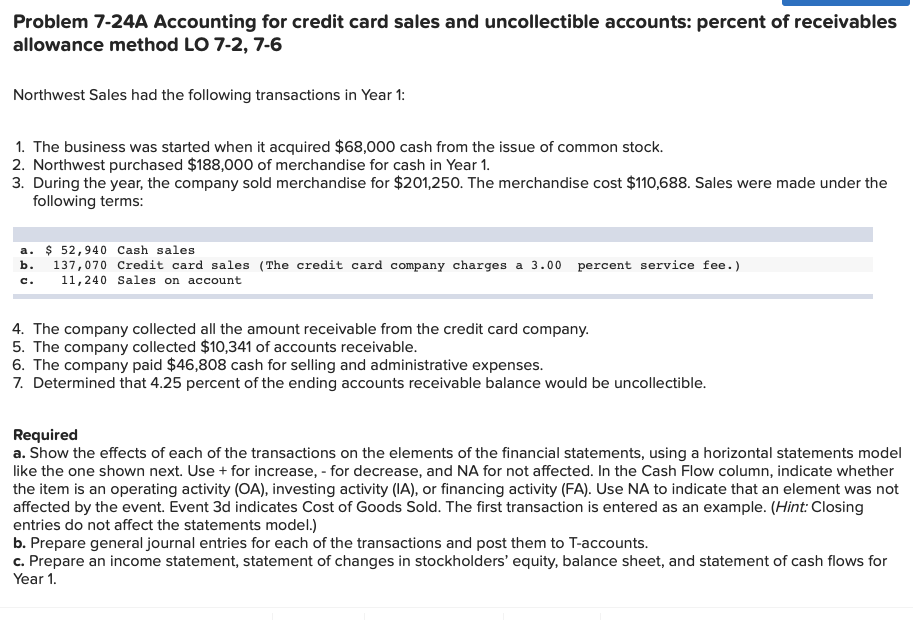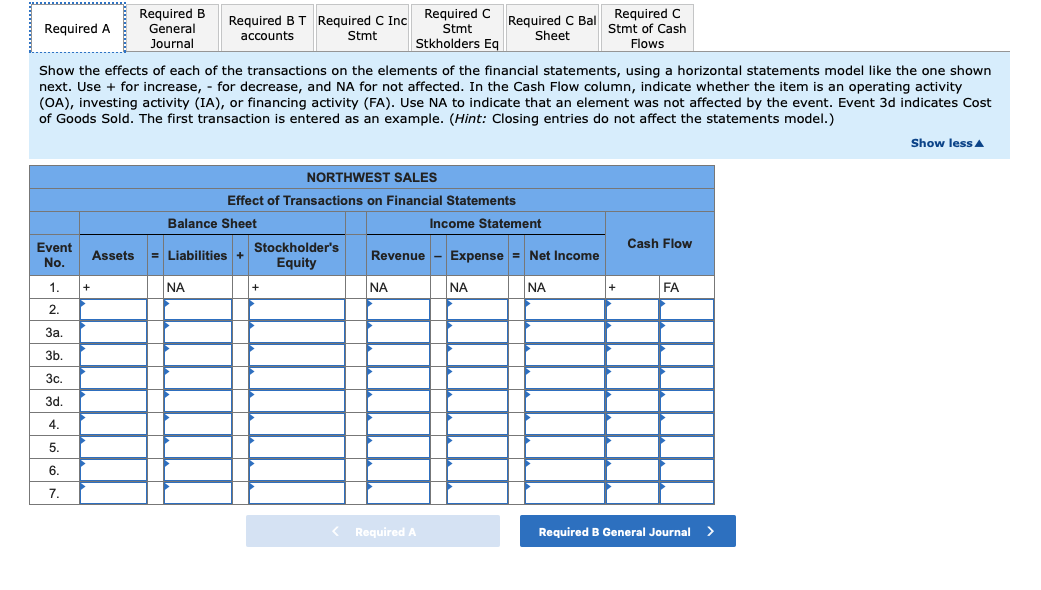

Problem 7-24A Accounting for credit card sales and uncollectible accounts: percent of receivables allowance method LO 7-2, 7-6 Northwest Sales had the following transactions in Year 1: 1. The business was started when it acquired $68,000 cash from the issue of common stock. 2. Northwest purchased $188,000 of merchandise for cash in Year 1. 3. During the year, the company sold merchandise for $201,250. The merchandise cost $110,688. Sales were made under the following terms: a. $ 52,940 Cash sales b. 137,070 Credit card sales (The credit card company charges a 3.00 percent service fee.) c. 11,240 Sales on account 4. The company collected all the amount receivable from the credit card company. 5. The company collected $10,341 of accounts receivable. 6. The company paid $46,808 cash for selling and administrative expenses. 7. Determined that 4.25 percent of the ending accounts receivable balance would be uncollectible. Required a. Show the effects of each of the transactions on the elements of the financial statements, using a horizontal statements model like the one shown next. Use + for increase, - for decrease, and NA for not affected. In the Cash Flow column, indicate whether the item is an operating activity (OA), investing activity (IA), or financing activity (FA). Use NA to indicate that an element was not affected by the event. Event 3d indicates Cost of Goods Sold. The first transaction is entered as an example. (Hint: Closing entries do not affect the statements model.) b. Prepare general journal entries for each of the transactions and post them to T-accounts. c. Prepare an income statement, statement of changes in stockholders' equity, balance sheet, and statement of cash flows for Year 1. Required A Required B General Journal Required BT Required C Inc Required C Stmt Required C Bal " accounts Stmt Stkholders Eq Sheet Required C Stmt of Cash Flows Show the effects of each of the transactions on the elements of the financial statements, using a horizontal statements model like the one shown next. Use + for increase, - for decrease, and NA for not affected. In the Cash Flow column, indicate whether the item is an operating activity (OA), investing activity (IA), or financing activity (FA). Use NA to indicate that an element was not affected by the event. Event 3d indicates Cost of Goods Sold. The first transaction is entered as an example. (Hint: Closing entries do not affect the statements model.) Show less NORTHWEST SALES Effect of Transactions on Financial Statements Balance Sheet Income Statement = Liabilities + Stockholder's Revenue - Expense = Net Income Cash Flow Event No. Assets = Liabilities + Equity NA NA NA NA FA Required A Required B General Journal > Problem 7-24A Accounting for credit card sales and uncollectible accounts: percent of receivables allowance method LO 7-2, 7-6 Northwest Sales had the following transactions in Year 1: 1. The business was started when it acquired $68,000 cash from the issue of common stock. 2. Northwest purchased $188,000 of merchandise for cash in Year 1. 3. During the year, the company sold merchandise for $201,250. The merchandise cost $110,688. Sales were made under the following terms: a. $ 52,940 Cash sales b. 137,070 Credit card sales (The credit card company charges a 3.00 percent service fee.) c. 11,240 Sales on account 4. The company collected all the amount receivable from the credit card company. 5. The company collected $10,341 of accounts receivable. 6. The company paid $46,808 cash for selling and administrative expenses. 7. Determined that 4.25 percent of the ending accounts receivable balance would be uncollectible. Required a. Show the effects of each of the transactions on the elements of the financial statements, using a horizontal statements model like the one shown next. Use + for increase, - for decrease, and NA for not affected. In the Cash Flow column, indicate whether the item is an operating activity (OA), investing activity (IA), or financing activity (FA). Use NA to indicate that an element was not affected by the event. Event 3d indicates Cost of Goods Sold. The first transaction is entered as an example. (Hint: Closing entries do not affect the statements model.) b. Prepare general journal entries for each of the transactions and post them to T-accounts. c. Prepare an income statement, statement of changes in stockholders' equity, balance sheet, and statement of cash flows for Year 1. Required A Required B General Journal Required BT Required C Inc Required C Stmt Required C Bal " accounts Stmt Stkholders Eq Sheet Required C Stmt of Cash Flows Show the effects of each of the transactions on the elements of the financial statements, using a horizontal statements model like the one shown next. Use + for increase, - for decrease, and NA for not affected. In the Cash Flow column, indicate whether the item is an operating activity (OA), investing activity (IA), or financing activity (FA). Use NA to indicate that an element was not affected by the event. Event 3d indicates Cost of Goods Sold. The first transaction is entered as an example. (Hint: Closing entries do not affect the statements model.) Show less NORTHWEST SALES Effect of Transactions on Financial Statements Balance Sheet Income Statement = Liabilities + Stockholder's Revenue - Expense = Net Income Cash Flow Event No. Assets = Liabilities + Equity NA NA NA NA FA Required A Required B General Journal >








